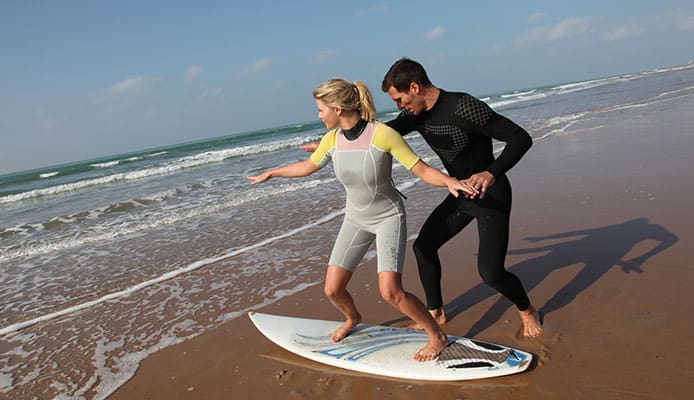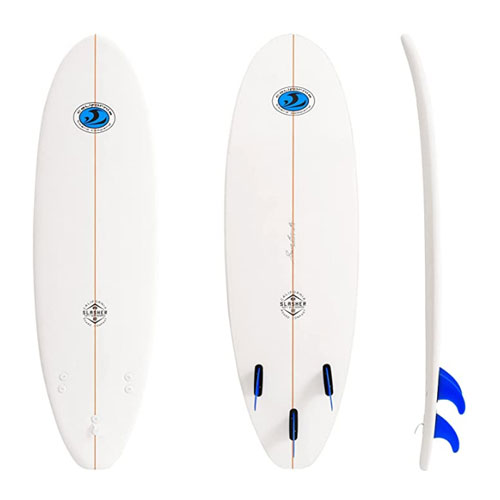-
1.
-
2.
-
3.
-
4.
-
5.
Surfing is a fantastic way to spend your day. It can be exhilarating and exciting and it is a great way for you to keep fit, find community, and find meaning in life. The only problem is that it can be daunting to try for the first time, which means that you need to know how to choose the best surfboards for beginners.
If you have tried paddleboarding, then it may be an easy transition as your balance is already there. The same is true for skating or skateboarding. But, balance is one thing, and being out in the waves is another thing altogether.
As always, we have taken the hard work out of the equation. We have found 10 of the best surfboards for beginners and compared all of their features. All you have to do now is choose the board which is right for you and get out on the water.
OUR TOP PICK
South Bay Board Co. 6’ Guppy Surfboard
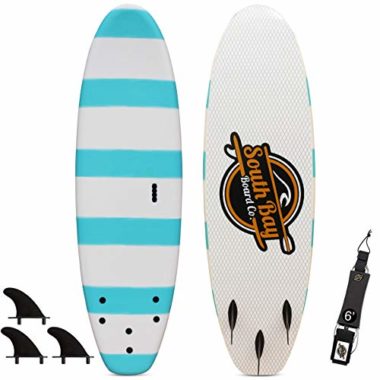
- Stand Out Features - Why We Love It
- Kids friendly shape that is extra buoyant
- A rigid build enables kids to learn to pop up
- Lightweight and easy to carry and handle for kids
- A built-in handle makes carrying even easier
- High-quality board built to last
Size: 6’ feet long x 21” inches wide x 3” inches thick
Beginner Weight Capacity: Up to 150lbs
Materials: IXPE form top deck, slick HDPE bottom deck, EPS closed cell foam core
Accessories Included: Fins, leash, and screws for the fin and leash
EDITORS CHOICE
Giantex 6′ Foamie with Removable Fins Surfboard
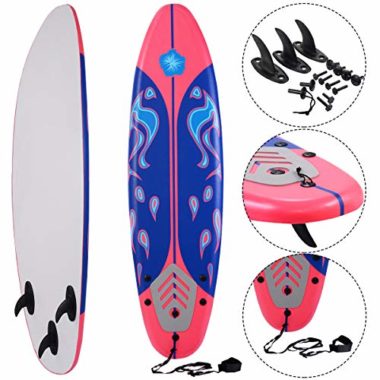
- Stand Out Features - Why We Love It
- Very easy for kids to handle
- Simple to assemble and carry on
- Lightweight and easy for kids to carry
- A pretty board with great colors
- Sturdy and decent quality
- You can't beat the price
- Perfect for learning to surf
Size: 72” X 20” X 3”(Length X Width X Thickness)
Weight: 10 Lbs
Beginner Weight Capacity: Up to 200 Lbs
Materials: EPE deck, EPS core, PP hard slick bottom
Accessories Included: Designed with a free leash and a transaction pad, comes with three removable fins
BEST VALUE
South Bay Board Co. Soft Top Foam Surfboard
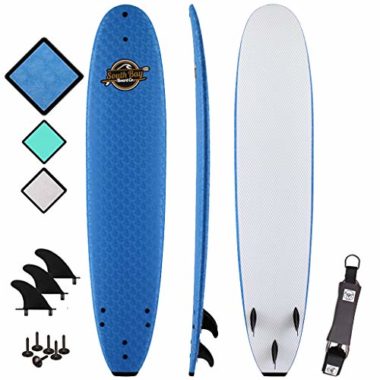
- Stand Out Features - Why We Love It
- A long, big board which is perfect for learners
- Beginner-friendly shape and nose and tail rocker
- Longboard surfboard inspired shape
- A plug on the nose for GoPro
- Plenty of volume, buoyancy, and stability
- Very well constructed to be durable yet forgiving and lightweight
- Grippy no wax fingerprint texture
Size: 8’ Feet 8” Long x 23” Wide x 3.25” Thick
Weight: 17lbs with fins and leash attached
Volume: 86 liters
Beginner Surfer Weight Limit: 100-230 lbs
Materials: IXPE foam top deck, HDPE bottom deck, EPS closed-cell foam core, two wooden stringers plus one fiberglass stringer, layers of resin
Accessories Included: leash, 3 fins, screws for the fins and leash
California Board Company 5-Feet x 8-Inch Surfboard
- Stand Out Features - Why We Love It
- Popular with young surfers
- Lightweight and an ideal size for young learners
- A forgiving soft top safe for kids to ride
- A grippy traction pad
- Has both buoyancy and maneuverability
- A fish surfboard at an unbeatable price
Size: 5 feet 8 inches long, 22.5 inches wide, 2.5″ inches thick
Weight: 6.5 pounds
Volume: Approx. 38.3 liters
Beginner Weight Capacity: Up to 190lb
Materials: EPS foam and plastic
Included Accessories: Tri-fin system and surf lease
Best Choice Products 6′ Foamie Surfboard
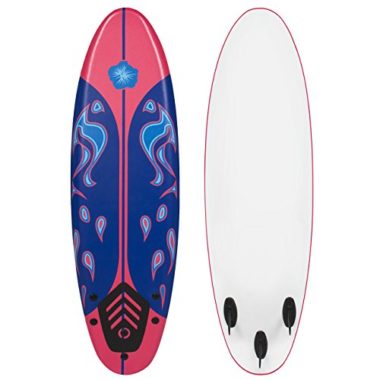
- Stand Out Features - Why We Love It
- Popular with little surfers
- A kid-friendly soft top with soft fins
- Lightweight and easy for kids to carry
- Just the right size for small kids to handle
- Cool design and colors
- Very easy for kids to learn on
- Inexpensively priced and decent quality
Size: 6′ feet long by 20.5 inches wide by 3.5 inches thick
Weight: 10 lbs.
Materials: Foam top, plastic bottom
Included Accessories: Three fins and leash
Wavestorm 8′ Brushed Graphic Surfboard
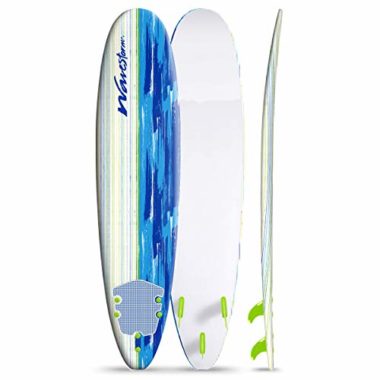
- Stand Out Features - Why We Love It
- A very popular and proven learn to surfboards
- Lightweight and easy to handle
- Plenty of volume, stability, and buoyancy
- Textured grip for stable foot placement.
- Beautiful multicolor graphics
- Strong bolt-thru components
- Solid and durable construction
Length: 8’0”, Width: 22 ½”, Thickness: 3 ¼”
Weight: 11.5lbs
Volume: 86 Liters
Beginner Weight Capacity: Up to 200 lbs
Materials: Foam top deck, EPS foam core, HDPE slick bottom, marine-ply stringers
Included Accessories: removable bolt-thru fins, ankle leash, traction pad
Grande Juguete 5’5″ Soft Top Surfboard
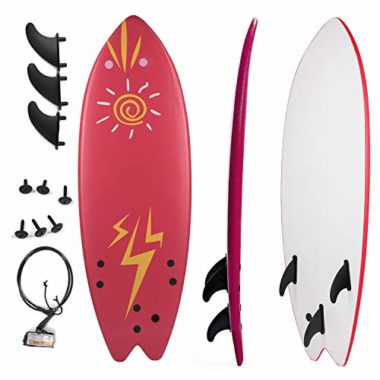
- Stand Out Features - Why We Love It
- Extremely durable construction that will keep you safe
- Built from high-quality materials that are perfect for a beginner
- A removable tale that can be sorted easily for providing easy transport
- Slick HDPE high-speed bottom to keep you stable
- Can reach fast speed due to the thruster design
- Perfect to learn to surf
Size:64”(L) X 20”(W)
Weight Limit: 150 lbs or less
Material: EPE(deck)+EPS(Core)+PP(Hard-Slick Bottom)
Color options: Red and yellow
Rock It 7′ SHORTBUS Soft Top Surfboard
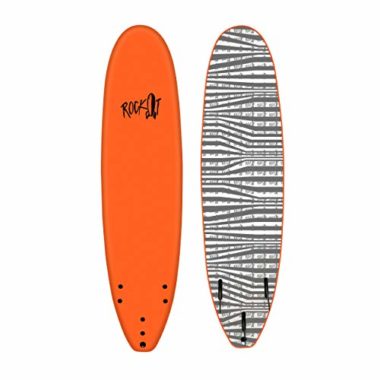
- Stand Out Features - Why We Love It
- Large enough to be capable of letting a variety of people surf
- Made by eco friendly materials that are involved in the process
- Manufactured with a lot of additional care towards the materials used
- Extra coats that are making it good enough to keep the colors
- Includes a UV resistant soft top layer
- Made with an epoxy nano-coating to resist water apsorbtion
Shipping Weight: 15 pounds
Product dimensions: 7′ x 21″ x 3″
Colors: Blue, green, orange, pink, red, teal, yellow, white
Material: EPS foam
ISLE Thumper 5’11” Soft Top Surfboard
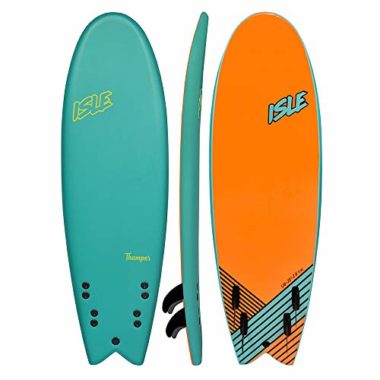
- Stand Out Features - Why We Love It
- The surfboard is small a very buoyant one
- It is made from a quality materials including an EPS foam core
- Made to help you reach fast speed without the need for the extra effort
- Will allow you to use it very flexible since it doesn’t have added weight
- Comes with a set of fins included in the package
Shipping Weight: 12 pounds
Dimensions: 4’11” x 21” x 2.5”
Capacity: up to 200 pounds
Colors: aqua, black, melon green
Rock-It 8′ Big Softy Surfboard
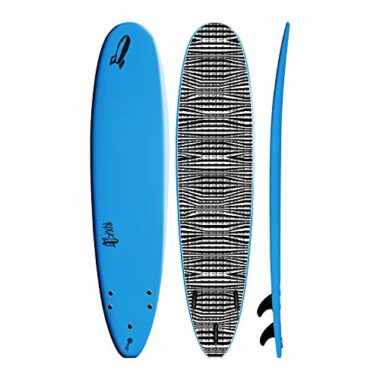
- Rock-It 8' Big Softy Surfboard
- Big and highly buoyant
- Stable yet easy to turn
- Performs well in all sizes of waves
- A forgiving soft top
- Built to take a beating
- Eco-friendly - core made from recycled EPS foam
- Variety of vibrant, highly visible color options
- Perfect to learn to surf
Size: 8′ long x 21.5″ wide x 3″ thick
Beginner Weight Capacity: Up to 225lbs
Materials: EPS foam core, wooden stringers, fiberglass cloth, epoxy resin
Accessories Included: 3 safety fins
How To Choose The Best Beginner Surfboard – Buying Guide
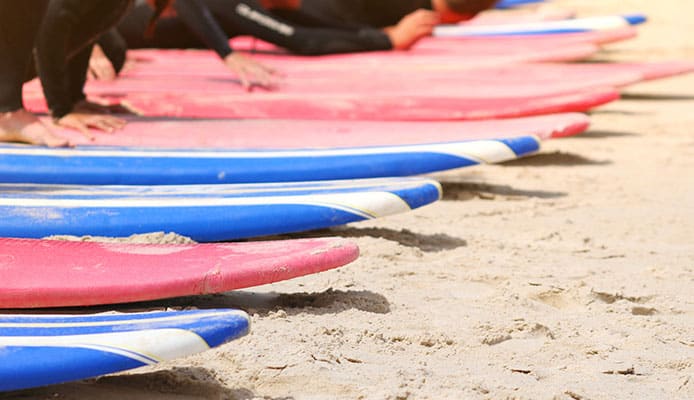
Being a beginner at anything means doing your research and finding out as much as possible about the topic. With surfing, you want to know a little about what you are in for, but, more importantly, you want to be able to find a board to surf with.
The difference between a surfboard for professionals and a surfboard for beginners is vast. Beginner surfboards are foam and less likely to injure you. They are also cheaper, making it less expensive to get into the world or surfing and to make sure you enjoy the sport before you commit to it.
Surfboard Basics
So what do you need to know before you buy your first surfboard? There are three main areas which you will want to concentrate on to give you a good idea of how the board will feel in the water.
The volume of the board will tell you how buoyant the board is. The heavier you are, the more buoyant you will need the board to be. The buoyancy is measured in liters. A board around 60 liters is standard.
You will also want to check the length of the board. Longer boards can be harder to handle, but as a beginner or larger adult, a longer board will be better for beginners.
The width of the board will determine the stability of the board. The wider the board is, the more stable it will be when you get to your feet.
Types of Surfboards
A professional surfboard is an attractive prospect, but probably not what you want to go for as a beginner. Surfboards are hard. They are designed for speed and maneuverability through the waves, but they can be a hazard to the novice rider, who will be coming off the board a lot. Foam surfboards for beginners are the way to go for someone starting out.
Foam boards are generally cheaper than regular surfboards. They are easier to take care of, tighter for transportation, easier to catch waves on, and will not crack your head open if you do collide with them.
Foam boards are a low-risk, low-cost investment for the beginner surfer. You also do not need to worry about waxing them.
You might also like: Surfboard Traction Pads
Anatomy of a Surfboard
Before you go out and buy your board, you should know some of the terms and lingo. We have compiled a list for you:
- The nose is the front of the board. The tail is the rear. This is where the fins are located (on the underside).
- The rocker is the underside of the board on the front. The rails are the sides of the board. The deck is the top of the board (where you will stand).
- The rocker is generally curved upwards. A small rocker will have a slight curve. A large rocker will have more of a curve.
- Rails can be low, medium, and high. The higher the rails, the flatter the board and the more attractive to beginners.
- Rails can also be hard and soft. Hard rails have sharper corners and cut through the water faster. Soft rails are curved and more manageable.
Best Starter Surfboard Brands
There are many surfboard brands out there. It is hard to know which shortboard for beginners options are better than others. While there are many companies that make great surfboards, there are some out there which been making boards for many years. These boards are made by surfers for surfers and have an eye on quality, details, and high-quality materials.
If you want to take a chance and have checked the reviews, then feel free to go with any company you wish. If the reviews are good, then you are likely getting a good board. The companies we especially like are BIC, Bodyglove, Surftech, and Gold Coast Surfboards. If you buy a board from any of these companies, then you will not be disappointed.
FAQs
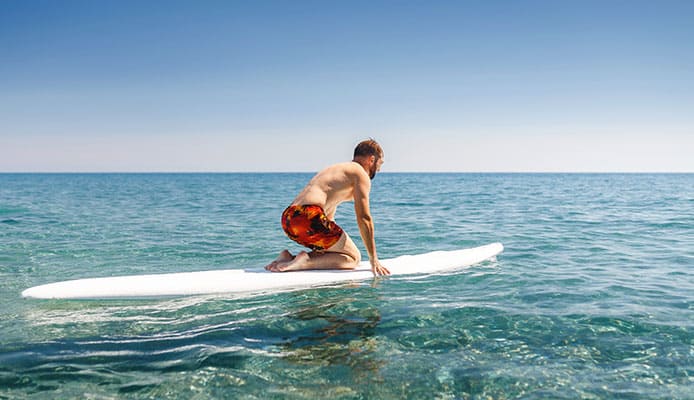
Q: How soon will I be able to get up on waves?
How long is a piece of string? The answer is that it is different for everyone. Anyone can get out into the waves as soon as they get a surfboard, but riding a wave will take some practice, and that can take different amounts of time for different people. Your fitness will play a part in this, as will your natural balance, though your balance can be refined. Focus on increasing your fitness and balance, and you should be up on a wave, sooner rather than later.
Q: Does surfing require a high level of fitness?
You do not need to be super-fit to surf, but then, you do not need to be super-fit to play basketball or soccer. The truth is, surfing can be enjoyable no matter your level of fitness, but the fitter you are, the more you will be able to do and enjoy sunbathing on the top-rated dry bag once you are done with the training.
Q: Should I take surf lessons?
Yes. Lessons for anything new are always a good idea. Getting tips and help from a professional will help you no end. Having said that, it is not entirely necessary. You can gain a lot of information from the internet or from talking to people who surf. Practice makes perfect, and getting out there in the water will help you no matter what. I would recommend getting some advice first so that you are starting on the right foot.
Q: How Do I Stand Up On a Surfboard
Standing up on a surfboard can be tricky, but it is a skill that you will need to master if you want to become a surfer. Here are some simple steps which can teach you the skill and improve your technique:
Practice first on land. Lay face-down on your board and have your toes touching the tail of the board. Place your hands palm-down on the board, close to your chest.
Push up your chest with your hands and stare ahead, not down at your hands. If you keep your eyes fixed on the horizon, you will have more balance.
Once you have mastered that (should not take long), you can move to the take-off. Go back to the original position and push your chest up. This time, as you do that, pop your feet in and jump them up onto the board. You should push yourself up so that you are in a crouched standing position.
Have your feet placed wide apart to give you balance, with one foot in front of the other? Have your leading shoulder pointing the way you want to go, and your face looking hat way too. Have your arms out to give you balance and stability. Practice this s few times on the beach.
Paddle out into the water and practice this same move in calm water to hone your balance.
Once you have it down, paddle out to a wave. Turn and allow the wave to push you. When you are angled down, it is time to jump up onto the board.
Globo Surf Overview
Surfing can seem daunting, but with the right board and a little practice, you can be out in the water and riding those waves in no time at all. Make sure to find a board base on your size, and even use some of the dry bag reviews to choose something to team it up. Also, remember that it is better to get a bigger than needed board than one which is not big enough. With one of the boards on our list, you will be assured that you are getting a quality board that will give you everything you need for your surfing adventure.


